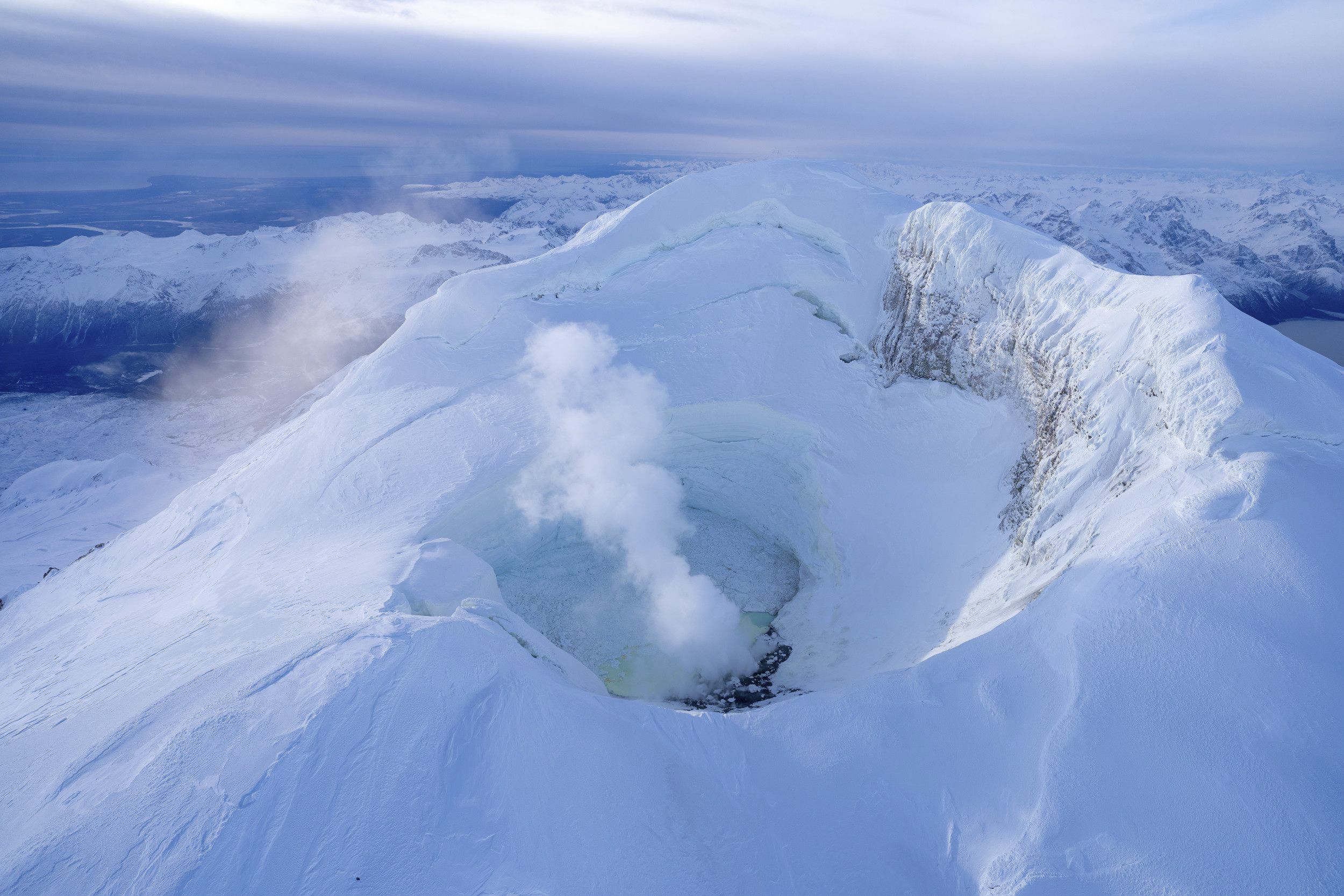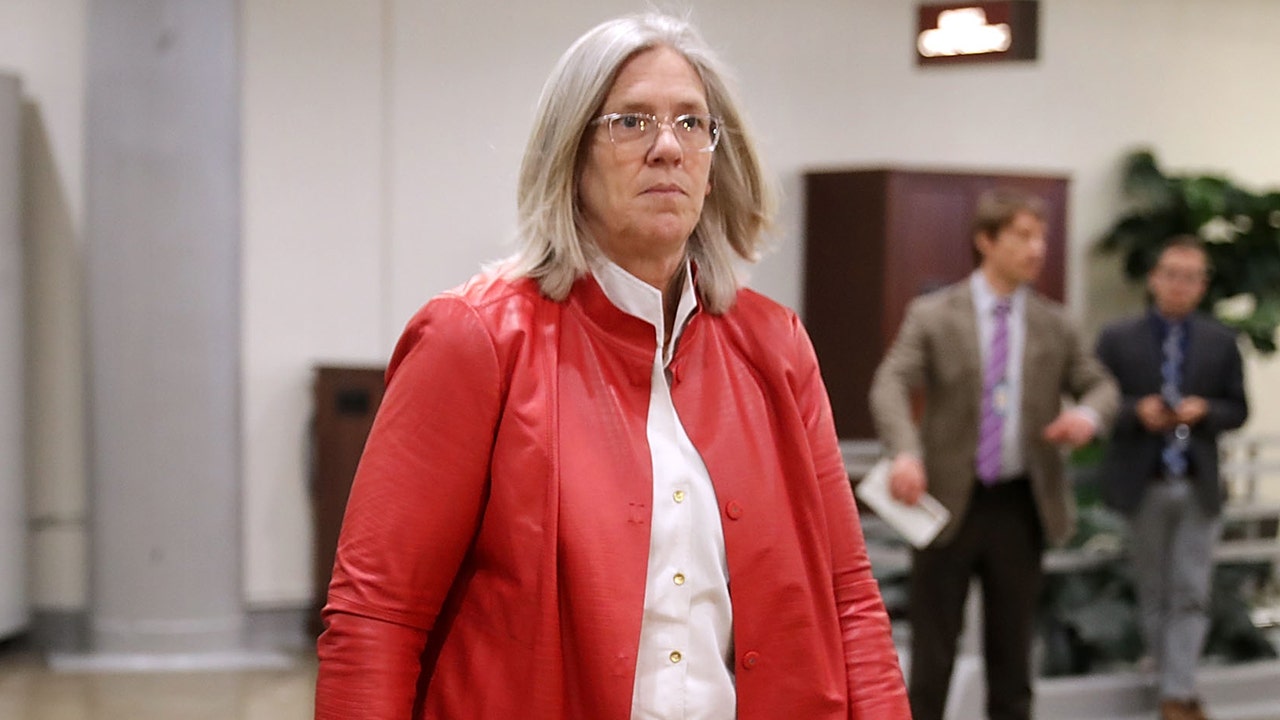Alaska
Beluga whales’ calls may get drowned out by shipping noise in Alaska’s Cook Inlet – Alaska Native News
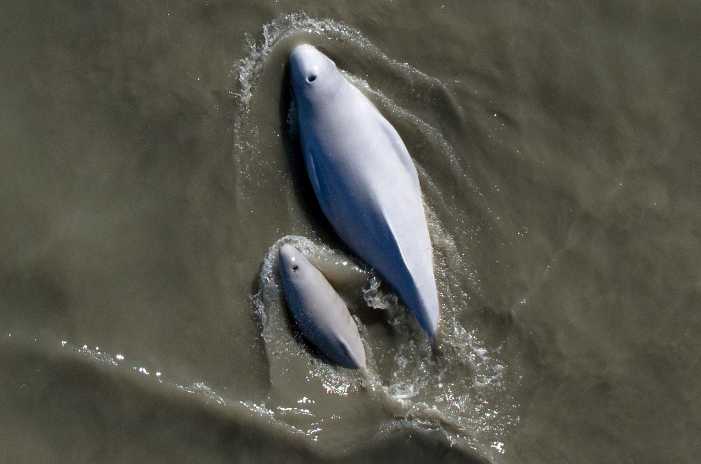
Beluga whales are highly social and vocal marine mammals. They use acoustics to navigate, find prey, avoid predators and maintain group cohesion. For Alaska’s critically endangered Cook Inlet beluga population, these crucial communications may compete with a cacophony of noise from human activities.
New research from the University of Washington, the National Oceanic and Atmospheric Administration’s Alaska Fisheries Science Center and the Alaska Department of Fish and Game is the first to document the complex vocal repertoire of the Cook Inlet beluga whale population. It is also the first to quantify how ship noise may be masking specific beluga calls in this region.
The study, published Nov. 30 in the Journal of the Acoustical Society of America, finds 41 distinct types of calls, of which 18 are unique to this population. It also finds that commercial ship noise completely masks these whales’ most commonly used calls.
“The core critical habitat for these whales is a very noisy area. Commercial shipping, an international airport, military operations and gas and oil exploration are all concentrated there,” said lead author Arial Brewer, a doctoral student in the School of Aquatic and Fishery Sciences at the UW who did the work in collaboration with NOAA Fisheries’ Alaska Fisheries Science Center.
“A fundamental knowledge gap for the Cook Inlet beluga population is how they communicate important information. The first step is to describe their vocal repertoire,” she added. “With that information, we can begin to understand if their communication is impacted by human-caused noise.”
Twenty-one populations of belugas are recognized worldwide, including five distinct populations in Alaska. The geographically and genetically isolated Cook Inlet beluga population is the smallest, recently estimated at just 331 individuals. Cook Inlet beluga whales live exclusively in their namesake waters alongside Anchorage, the state’s largest city and busiest port.
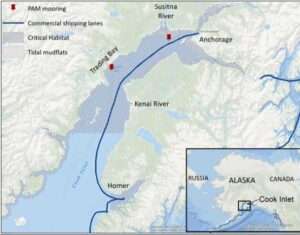
The Cook Inlet beluga whale population was listed as endangered under the Endangered Species Act in 2008. A 2016 recovery plan ranked three threats as the highest level of concern, one being human-caused noise. Commercial shipping is the most prominent noise source within Cook Inlet, particularly in the upper inlet where most of the federally-designated critical habitat is located.
”All of that human-caused noise means the belugas may not hear critical communications from each other, such as predator alarm calls or a mother calling to her calf,” Brewer said.
While all whales are affected by noise, Cook Inlet belugas may be particularly vulnerable to noise as a stressor.
“Cook Inlet is extremely turbid year-round from glacial runoff. It looks like chocolate milk,” Brewer said. “Acoustic communication is extremely important for this population since visibility is so poor. And, unlike other, higher-Arctic beluga populations, this population is non-migratory, so they are exposed to this noise year-round.”
Cook Inlet’s extreme turbidity, dramatic tides, rapid currents and seasonal ice cover make it an extremely challenging place to study belugas. One way scientists can monitor these highly vocal whales is through sound.
The Cook Inlet Beluga Acoustics Program has been deploying bottom-mounted passive acoustic recorders to monitor belugas and human-caused noise since 2008. The study focused on recordings of beluga whale calls from 2018 to 2019.
“Until now, we did not have a quantified measure of masking by ship noise on Cook Inlet beluga communication. We knew this was a potential disturbance mechanism to focus our research efforts, but we were lacking a good understanding of what vocalizations are most important for beluga,” said co-author Manuel Castellote, a research scientist at the UW-based Cooperative Institute for Climate, Ocean and Ecosystem Studies who manages the acoustics monitoring program. “This study provides the first two steps into this direction: We now have a solid understanding of key vocalizations for this population, and how each ship transit is affecting beluga vocal exchange in the core area of their critical habitat.”
For the new study, scientists analyzed recordings at two critical habitat locations: Susitna River, just outside of Anchorage, and Trading Bay, farther out in the inlet.
They classified beluga vocalizations into three broad categories — whistles, pulsed calls and combined calls — and then further into 41 unique call types.
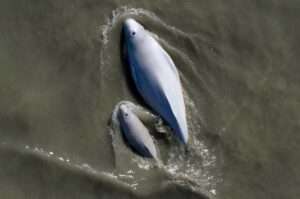
“I’ve spent thousands of hours listening to this population. Anytime I find a new call type, it’s really exciting,” Brewer said, “Eavesdropping on their world is really fascinating.”
The study found that the Cook Inlet beluga population, like other beluga populations, has a rich and complex repertoire. Vocal repertoire has been documented for eight of the 21 populations of belugas worldwide. Results from this study support the hypothesis that some call types are shared across populations, while others are unique.
Of the 41 types of calls the authors documented in the Cook Inlet population, 18 were not documented in any other population; 16 were documented in some but not all of the previously studied populations; and seven were common to all populations studied so far.
“Differences in vocal repertoire among different beluga populations may be driven by unique evolutionary, environmental or cultural influences,” Brewer said. “The divergence of the Cook Inlet vocal repertoire may be in part due to the population’s long-term geographic and genetic isolation.”
The researchers next looked at how the most commonly-used call types may be masked by human-caused noise. They focused on commercial ship noise, which is the most prominent noise type in Cook Inlet.
Analysis found that all seven of the most commonly-used call types in the Cook Inlet beluga vocal repertoire were partially masked by the time a commercial ship was within about 10 miles (17 kilometers) of the study site. Calls were completely masked when the vessel was closest to the site during the transit through the designated shipping lanes.
Roughly 486 commercial ships use the Port of Alaska annually, with an average of 8-10 ships coming and going per week. It is estimated that each ship passage will mask beluga communication at the study site for 1 hour and 50 minutes on average.
“Our results suggest that every time a commercial vessel transits through the Port of Alaska shipping lanes, Cook Inlet beluga communication could be heavily impacted within their core habitat,” Brewer said.
“Humans are such a visual species. It’s hard for us to comprehend how noisy it is under the surface of the ocean and how much noise impacts marine mammals such as belugas. We hope our findings will lead to further studies to better inform management about these types of human-caused impacts.”
The research was funded by NOAA Fisheries, Hilcorp Alaska LLC, Georgia Aquarium, Shedd Aquarium, the SeaWorld-Busch Gardens Conservation Fund and the H. Mason Keeler Endowed Professorship in Sports Fisheries Management at the UW.
Other co-authors are faculty members Amy van Cise and Andrew Berdahl in the UW School of Aquatic and Fishery Sciences; and Tom Gage at the Alaska Department of Fish and Game.
For more information, contact Brewer at arialb@uw.edu or Castellote at manuelcm@uw.edu.
Adapted from a NOAA feature story.
U of W

Alaska
Burn him down: A history of effigy-burning protests in Alaska

Part of a continuing weekly series on Alaska history by local historian David Reamer. Have a question about Anchorage or Alaska history or an idea for a future article? Go to the form at the bottom of this story.
What do Fairbanks, Alaska, and Tehran, Iran, have in common? Not a riddle but a genuine question. People are people everywhere, driven by similar base needs and desires, so don’t be fooled by the more obvious geographic and cultural divides. There’s more than one similarity. Still, a particular detail stands out. Effigies of President Jimmy Carter were burned in both towns, nearly twin moments separated by continents.
There is a long history of strident political protest in Alaska from all points along the political spectrum. Liberal protests. Conservative protests. Serious protests. Silly protests. Protests in all shapes and forms. In 1911, residents at Cordova shoveled a shipment of coal into the harbor to protest land conservation efforts that forced Alaskans to import coal rather than mine it here. It was a Cordova Coal Party. For a different tone entirely, what is now the University of Alaska Fairbanks banned alcohol on campus in 1957. Students predictably disliked the new policy and dug a grave, which was filled with beer bottles and topped with a concrete headstone with a metal plate that read: “Here Lies Tradition, 1957.” Or, who remembers the Annoy Prevo: Think For Yourself bumper stickers of early 1990s Anchorage lore, referring to Baptist minister Jerry Prevo?
Like the Cordova Coal Party, some of these protests coalesced into genuine cultural moments that are crucial to understanding the flow of Alaska history, events such as the 1961 Barrow Duck-In and the 1979 Denali Trespass. For all that, there is something more pointedly personal about burning an effigy. More than a stand against a policy or platform, effigy burnings seek to destroy the person, symbolically at the least, wish fulfillment at the most. And Alaska history is likewise generously dotted with a series of effigy burnings. The following is a review of some but not all effigy-related protests in Alaska history, the most important, memorable and ridiculous.
Burning effigies as a form of protest is an ancient practice. The leap in logic from having an enemy to destroying them by figural proxy is short. History abounds with examples. From 1328 to 1329, the Holy Roman Emperor Louis IV, usually via his puppet Antipope Nicholas V, burned several effigies of Pope John XXII, after those effigies had been tried and condemned naturally. In 1919, a group of women suffragists lit a 2-foot-tall straw and paper effigy of President Woodrow Wilson on fire in front of the White House. Wilson had been slow in support of the female vote. Nicholas V eventually submitted to Pope John XXII and spent the remainder of his life as a less-than-willing guest within the papal palace. The protesting suffragists were immediately arrested, although Wilson did reluctantly call a special session where the eventual 19th Amendment was passed.
Moreover, a burning effigy is typically a display of citizen power. They are a fundamentally public act; try one inside your home if you think otherwise. The American history of effigy burning predates the Revolutionary War. In late 1765, several English newspapers published a letter from Boston. The author reported, “two effigies, one of which by the labels appeared to be designed to represent a Stamp Officer, the other a Jackboot with a head and horns peeping out of the top.” These effigies were hung from a tree, then paraded through town and burned atop a hill.
The horned “Jackboot” referred to John Stuart, 3rd Earl of Bute, the British Prime Minister from 1762 to 1763 and even thereafter a close adviser to King George III. American colonists reviled Stuart for his preferred policy of heavily taxing the colonies. This included the 1765 Stamp Act that required all Americans to pay taxes on printed paper, including playing cards. The Act prompted the “taxation without representation” line and was a significant catalyst for the revolution that began 10 years later. Stamp officers collected the taxes — in British, not colonial currency, mind you — and were thus obvious targets of abuse and effigy practice.
In the spring of 1910, U.S. Marshal Daniel Sutherland and U.S. District Attorney John Boyce were dismissed from their Alaska posts in favor of men known as stooges for the Morgan-Guggenheim Alaska Syndicate, which sought to monopolize the territory’s transportation, mining and fishing industries. James Wickersham, Alaska’s non-voting Congressional representative, accused Gov. Walter Clark of also being in league with the Syndicate. Like many other Alaskans, Wickersham believed that Clark influenced the removals of Sutherland and Boyce. On April 26, Clark was burned in effigy at Juneau. He publicly laughed off the demonstration in the way that only a highly connected, protected man can. The governor, replacement district attorney and replacement marshal remained in their posts.
Gifford Pinchot was a close confidant of President Theodore Roosevelt. They shared a commitment to the protection of public lands, and Roosevelt accordingly appointed Pinchot as the first Forest Service chief, a position he held from 1905 to 1910. As regards Alaska, Pinchot influenced policies that sought to block the rapacious Alaska Syndicate from exploiting natural resources in the territory. To be clear, his intent was more conservation than preservation, in that he favored responsible and rational resource extraction. However, such attempts to curb more ruthless exploitation did hinder smaller-scale settler development.

Pinchot was therefore widely hated by settler Alaskans. His name was in the mind of every Cordova Coal Party participant. Still, such animosity was far from universal. Juneau of this era was less dependent upon new mining developments than a place like Cordova, which goes to why Gov. Clark was burned in effigy for supporting the same Syndicate opposed by Pinchot.
Katalla, southeast of Cordova, is a ghost town now. It was once a bustling boomtown boasting a few thousand residents but was in swift decline by 1910. The town relied upon the passage of oil and coal for its existence. Blocked development on nearby coal fields meant its demise, and to a person, the residents hated Pinchot. On May 3, 1911, an effigy of Pinchot was burned on the beach there.
By then, Pinchot was not even in office. President William Howard Taft dismissed him in January 1910, a key moment of what became known as the Ballinger-Pinchot Affair. In a very long story made short, Pinchot publicized efforts by Secretary of the Interior Richard Ballinger to subvert conservation efforts in favor of a company that was part of the greater Alaska Syndicate, including with lands in Alaska. Ballinger resigned in 1911, coincidentally working with the same corporate interests. The Taft administration’s efforts to cover up the scandal split the Republican Party and aided the Democrat Woodrow Wilson’s win in the 1912 presidential election.
A more curious incident happened in 1912 Kennecott. Per the Cordova Daily Times, “Some of the Chitina people now believe that in officialdom there a nest of foreigners lord it over Americans.” That March, residents burned an effigy of U.S. Commissioner M.R. Healy, who they believed was not an American citizen. In that, they were right. Healy was Canadian. He admitted to previous lies and was subsequently naturalized but resigned his position.
While most effigies are personal in nature, some represented a broader warning. In May 1912, some miners in the Fairbanks region hung an effigy as a warning for any possible firebugs. It had been a dry spring, and several cabins had burned due to careless fires.
In 1911, the Washington-Alaska Bank of Fairbanks failed and closed its doors with a $1 million in local deposits on its books. Later that year, depositors received half of their money, which comprised the entirety of the recovery for most locals. Blame fell almost entirely upon E.T. Barnette, the bank’s president until just three months prior. Fairbanks as a town originated with Barnette’s trading post on the Chena River, located where he was forced to disembark from a riverboat that could proceed no farther upstream.
Barnette aspired to be a pillar of the new community and briefly swam at the upper echelons of frontier society. Against this desire, he had a habit of cutting corners, of stealing from partners, and for disappearing when needed the most. He was a schemer, and his reputation eventually reached the Earth like the inevitable path of a thrown baseball, once clean and white but destined for the dirt. When the bank failed, Barnette was living in Los Angeles, with greater interest in his Mexican plantation than anything happening in Fairbanks.
The declining local economy — the bloom was well gone from their gold rush heyday a few years prior — played a role in the bank’s decline. However, Barnette’s management was the most significant factor. For example, he used the bank to liquidate himself of company stock at inflated prices, with the institution hiding the ramifications of the stocks’ declining value until years later. While in town, Barnette was incentivized to prop the bank up, to maintain its operation. He personally guaranteed any overdrafts of the bank’s holdings. Once he left in the fall of 1910, he made sure to take all of his own deposits with him.
An embezzlement charge went to trial in December 1912. To the great shock of all observers, Barnette was found not guilty of all major charges and only fined $1,000, a small percentage of the fortune he left town with two years before. Fairbanks Daily News-Miner editor W.F. Thompson described the ruling as “the rottenest judicial farce the North has ever witnessed.”
A few days later, a mysterious advertisement was pasted around Fairbanks. “All Fairbanks invited to attend open air New Year celebration. Monday evening, Jan. 6 at 8 o’clock. Everybody come to the waterfront.” Not having anything better to do on a January evening in the time before radio, TV, or internet, much of the town turned out for the show. A group of women with lost deposits in the Washington-Alaska Bank constructed three effigies. Two of them depicted John Clark and John McGinn, Barnette’s lawyers. The last effigy was of Justice, seemingly abandoned in Alaska. After a lengthy expository prayer, the effigies were burned with cheers heard for several blocks. Pictures of the event were subsequently exhibited at the theater.
The Alaska Railroad Act, which authorized and guaranteed funding for the construction of that railroad passed in March 1914. For many in Alaska and Washington, D.C., a government-owned railroad was a way to circumvent corporate interests like the aforementioned Alaska Syndicate and yet promote more independent development in Alaska. In theory, such a railroad would balance conservation and settler self-determination. Yet, a few Alaskans disliked the concept.
On April 13, 1913, seven senators of the Alaska Territorial Legislature submitted a letter to Secretary of the Interior Franklin Lane. The legislators agreed that a railroad in Alaska was “an imperative necessity to the development of our vast mineral resources.” Instead, they argued, “The majority of people, in our opinion, are opposed to the principle of government ownership.”
Despite the veneer of authority, the letter was not an official missive from the Territorial Legislature. Furthermore, the letter certainly reflected a minority opinion within the Legislature. In a speech to the House of Representatives, James Wickersham noted, “Out of 24 members of the legislature, seven of them have sought to prevent the passage of the Alaska railway bill by sending this communication to Washington to be used in debate, at the moment when it would do the Territory of Alaska the greatest amount of harm, by the opponents of the bill.”
The existence of the letter did not become public knowledge until early 1914 when it was weaponized by opponents of the railroad bill. The Alaska public response suggests the seven men had not misjudged the support for a government railroad so much as willfully misrepresented its nature. Indeed, in Alaska, those same men had acted more neutrally toward the idea of a government-owned railroad. The Territorial Senate had notably declined to take a public stand on either side of the railroad bill.
The public response to the letter was heated. In Cordova, pioneer resident George Dooley led a group that hung seven effigies on a line across the town’s main thoroughfare, one for each signatory to that letter. A sign on them declared: “The Traitors to Alaska.” They swung in the breeze for a while before they were taken down and burned. The implied threat was possibly not an empty one. The Petersburg Herald suggested, “the rebuke administered to the traitors by the Cordovans was much too mild for the offence. Fortunately, the end is not yet.” A bit ominous, that.
The next day, the Cordova Daily Alaskan made an observation that ties this era of effigy burnings together. Their editor opined, “Pinchotism’s blight on Alaska has forever been removed.” Four years after Taft dismissed Pinchot, Alaskans still frequently blamed the former Forest Service chief for lack of development in the territory.
Truly, the early 1910s were the heyday of effigy burning in Alaska. Alaskans hated the government, even the presence of the government, but at the same time had high expectations for government performance and expected the government to make their lives better. It was an uneasy, contradictory perspective on the world in a rapidly changing time. Firestarters abounded, as apparently did experts in life-size doll making.
The practice of burning effigies thereafter dwindled in popularity and severity, excepting that of President Carter. In 1934, Fairbanks hosted its first Ice Carnival, which inspired the creation of the Fur Rendezvous two years later. On the event’s last day, March 11, an effigy of “Old Man Depression” was burned on the banks of the Chena River. Old Man Depression was a personalization of the Great Depression, burned as a symbolic attempt to free themselves from what seemed like an eternal economic despair. This was far from an original act. Old Man Depression effigies had been buried, burned, and hung in towns across the country since 1930 and for several years after that Ice Carnival.
In March 1961, a 17-year-old student at Anchorage’s West High School hung an effigy of Principal Leslie Wells near the school. Wells was, of course, demonstrably guilty of keeping kids from doing all manner of cool things. Again, some effigies and some protests are more serious than others. Further indignities, including fire, were likely planned for the effigy, but the ringleader and his accomplices were quickly apprehended. Per the contemporary coverage, “A policeman patrolling the area nabbed the perpetrators and gave them 20 minutes to remove the ‘dummy.‘” No charges were filed, which is a constant with effigy protests in Alaska.
One month later, in April 1961, Gov. Bill Egan proposed a sweeping measure that would raise taxes on everything from alcohol to income. Many of these marked dramatic increases, as with a 60% higher cigarette tax. George Allen of Chugiak, an Alaska Democratic Party district vice chairman, suggested Egan be burned in effigy, even promised a local meeting on the idea. Notably, Egan was also a Democrat. There was a vote, and effigy burning lost in favor of a recall campaign that was in turn eventually abandoned.

The recently passed Jimmy Carter was the modern equivalent of Gifford Pinchot, as regards that specific intersection of land conservation, preservation, development, and rabid Alaskans. On Dec. 1, 1978, President Carter invoked the 1906 Antiquities Act and created 15 national monuments in Alaska and enlarged two others, withdrawing 56 million acres from possible resource development. The withdrawals were part of the long aftermath of the 1971 Alaska Native Claims Settlement Act and a bridge over congressional gridlock until the passage of the 1980 Alaska National Interest Lands Conservation Act.
Like the residents of Katalla and Cordova decades earlier, broad swaths of Alaskans were incensed at Carter and Interior Secretary Cecil Andrus for blocking development and, as they saw it, denying Alaskan self-determination. Groups of picketing protesters became a common scene in Anchorage, Fairbanks, and several other Alaska towns. Some of the signs pictured Carter hanging in a noose. In Ketchikan, two life-sized straw effigies of Carter and Andrus were tossed into the water. Organizer Ted Clifton declared, “We’re going to drown them here.”
Over the next several months, park rangers were repeatedly insulted and openly threatened across the state. A movement emerged in Eagle to expel any National Park Service, or NPS, presence from town. As a 1979 resolution declared, “The city council of Eagle Alaska does not advocate violence, but we can be no more responsible for the actions of an individual citizen than we can be for any animal when it is cornered.” An arsonist torched an NPS Cessna at Tazlina. In Glennallen, a business hung signs declaring, “We reserve the right to refuse service to anyone. Park Service personnel not welcome.”
In January 1979, a mass protest occurred at what is now Denali National Park. Known as the Denali Trespass, a few thousand Alaskans gathered with the stated intent to break every possible rule, regulation, and law. They drank every intoxicant in sight, hunted when they weren’t indiscriminately firing guns, built bonfires, and drove snowmachines everywhere. Some conducted target practice on images of King George III with a “Carter?” inscription. They dared any official to arrest them, but park rangers simply observed from a distance. One intoxicated demonstrator died when he drove his snowmachine onto a landing strip and into an airplane.
And there was that effigy burning, that link between Fairbanks and Tehran. Carter was burned in effigy on December 11, 1978, a planned event conducted at the downtown Fairbanks post office. An advertisement for the protest ran in the News-Miner, placed by the “Interior Wildlife Association,” and depicted Carter with an Adolf Hitler-style mustache. Then Fairbanks Mayor William Wood attended and participated, as did past mayors Harold Gilliam and Paul Haggland.

When Jimmy Carter died at the end of 2024, most Alaska commentators adopted a soft approach toward the former president, and understandably so. But the antipathy toward Carter in late 1970s Alaska was real, a vicious and bitter movement. It was far more malevolent than dunk tanks at the state fair with his pictures of his face, something that also happened.
Some historians have claimed there was no unanimous late 1970s Alaska hostility to Carter and land conservation. While technically true, the opposition to Carter from late 1978 through the end of his presidency was overwhelming in effect. Per a July 1979 poll, only 16% of Alaskans approved of Carter’s actions. By that same poll, only 10% of Alaskans favored him for reelection. And at that next election, Carter pulled only 26% of the Alaskan electorate, almost 10 percentage points worse than his performance in 1976 and the worst performance by a Democratic presidential candidate in Alaska history.
Perhaps the most amusing effigy burning incident in Alaska involved a fast-food clown. In 1989, the announcement of a new McDonald’s location in Fairbanks sparked anger among area residents. Zena Toy burned two Ronald McDonald effigies on her lawn and hung a third during the construction. She told the News-Miner, “There’s going to be giant golden arches and stinky hamburger smell and tons of Styro on Geist Road.” Bob Morton lived two blocks away from Toy and supported the new franchise, the fourth in Fairbanks. He said, “I think it’s great. And I thought her Ronald McDonald was cute, but dumb.” The franchise owners did build a wall separating the restaurant from its residential neighbors.
In the spring of 1992, the House Finance Committee passed a budget proposal with significant funding cuts for the University of Alaska, including $1.4 million from UAF’s operating budget. Gov. Wally Hickel’s capital budget included nothing for UAF’s long-deferred maintenance. At the same time, UA system administrators were considering a steep increase in tuition costs. Meanwhile, UAF students went to class and watched the buildings fall apart. Burst radiators and crumbling ceiling tiles were a common sight.
On April 15, around 400 students protested on campus, organized by SWARM, the Student Walkout and Resistance Movement. There were signs like “GIVE US OUR MONEY,” “STOP HICKEL’S RAPE OF UAF,” and “UAF NEEDS A FUTURE.” Eight mostly naked women streaked through the crowd shouting over and over, “We got stripped by Wally Hickel!” An effigy of Hickel was burned to great cheers. That night, about 100 students occupied the Butrovich Building for a peaceful sleep-in. The mere existence of the Butrovich Building, built to house administration offices, angered many students given the proliferation of asbestos and leaky roofs in dorms and classrooms.
The student protest galvanized students toward distinct goals and defined a coherent community. Yet, they were also less successful in reaching those goals. After long ignoring student demands for a meeting, Hickel finally agreed to a teleconference, though the budget cuts continued. Nine days after the protest, the UA Board of Regents passed an unaltered tuition hike.
The historical precedent and Alaskan preference are clear. Over and over, for more than a century, protests in Alaska have been plentiful and varied, sharp and even aggressive in approach. For decades, it has been a credit to our society and government that such protests are both familiar and allowed. For sure, the ways in which a government treats protesters is a barometer of freedom. Read the measurements however you want.
Alaska
WNBA’s Alissa Pili and Olympic medalist Kerry Weiland highlight Alaska High School Hall of Fame Class of 2025 – Anchorage Daily News

The Alaska School Activities Association announced the Class of 2025 of the Alaska High School Hall of Fame on Friday. Among the dozen individuals who will be inducted are former Dimond multisport star and current professional athlete Alissa Pili and Palmer women’s hockey trailblazer Kerry Weiland.
The ceremony honoring the class is at 2 p.m. April 27 at the Special Olympics Alaska Jim Balamaci Training Center in Anchorage.
The Hall was established to recognize and permanently honor individuals who displayed “high ethical standards and integrity while achieving excellence in high school athletics and activities,” according to ASAA. It also recognizes those who have made “exemplary contributions” to the prep sports and activities landscape on the Last Frontier.
Categories include students who participated in athletics, academic activities and fine arts, as well as contributors who served as coaches, advisers, directors, administrators, officials and adjudicators. Any former student must have graduated at least five years ago to be eligible for induction. This year’s class marks the 20th in the hall’s history and features 10 athletes and two activities teachers/coaches.

Athlete inductees
Pili racked up a staggering 13 state championships during her time in high school, including leading the Lynx volleyball team to four straight titles in volleyball and the basketball team to a pair of state titles. As an individual, she won four state titles in shot put, two in discus and another in wrestling. The 2019 graduate went on to have a stellar collegiate career in basketball, including being named Pac-12 Freshman of the Year at USC and later Pac-12 Player of the Year at the University of Utah. She now plays professionally in the WNBA for the Minnesota Lynx after being drafted No. 8 overall in the 2024 WNBA Draft.
[Playing at a new level, Anchorage’s Alissa Pili finds her footing and connects with fans]
Weiland was not only a trailblazer for women’s hockey during her time at Palmer High School, she starred in the sport. She made history as one of the first girls in Alaska’s history to compete on a boys varsity hockey team, and earned First Team All-Region honors. She parlayed her standout prep career into a full-ride scholarship at the University of Wisconsin, where she earned All-American First Team honors in 2002. Weiland competed professionally both domestically and internationally, winning an International Inline Roller Hockey Championships and helping Team USA bring home a silver medal in the 2010 Winter Olympics.
“Kerry was always respectful and quiet, but on the ice, she wasn’t afraid of anything,” childhood friend and fellow Alaska sports legend Scotty Gomez said in a statement. “She was the real deal.”
Freddy Hamilton III helped make Craig High School a powerhouse basketball program during his four years. From 2001-2003, he spearheaded Panthers teams that dominated the Region V 3A level, finishing as state runner-ups in 2002 and state champions in 2003. Hamilton was named to the Region V 3A All-Tournament Team for three straight years and the State All-Tournament Team as a junior and senior.
“Freddy was one of your first two-way players, an exceptional point guard/forward who made it very difficult for the opposing team to guard him,” former Craig assistant coach James Mackie said in a statement.
AJ Hull was a multisport star at Kenai Central High School and led Kardinals teams to three state championships, two in football and one in baseball. The 2012 graduate’s list of individual accolades includes being named Gatorade Player of the Year in 2011, Offensive Player of the Year and State Outstanding Player in football where he was also a three-time First Team All-State quarterback and two-time All-State at defensive back. As a senior in basketball, he was named First Team All-Region and Second Team All-State, and then on the baseball field, he led the 2012 American Legion state championship team and was named tournament MVP. That year he also received the Big Stick Award and was named Northern Lights Player of the Year and First Team All-State.
Rachel Johnson was a three-sport standout at Nikiski High School, where her list of accomplishments included receiving multiple First-Team All-State honors in volleyball and basketball and shining as a goalkeeper in soccer. She continued to shine on the pitch in college at Highline College, where she set a school record with an 11-game shutout streak, and then at Washington State University, where she helped lead the Cougars to big wins against nationally ranked opponents.
“Rachel’s leadership stands out as a primary reason for our fond memories,” her former coach Scott Anderson said in a statement. “She made us a team, not just a group of individuals.”
Luke Johnson was a four-sport star at Nikiski High School, where he produced three straight undefeated seasons in wrestling and capped off each with a state title. He finished as the state runner-up to his older brother as a freshman. On the football field he helped lead the Bulldogs to four straight state title appearances from 2012-2015, winning it all in 2013 and finishing runner-up in the other three. As a senior in track and field, he won at state and set a new school record in the shot put and came in second at state in discus for the second year in a row.
“Luke’s leadership on the field was unparalleled; he always led from the front,” his coach Jake Doth said in a statement.

Tobin Karlberg was one of the best basketball players of his generation, and his long list of accolades includes leading the Grace Christian boys team to three straight state championship game appearances and a title in 2017. That was the same year he was named 3A State Player of the Year, for the second year in a row, and the Gatorade Alaska Player of the Year. After high school, he kept his talents close to home and starred at the University of Alaska Anchorage before finishing his career at Point Loma University. He now serves as an assistant coach on the staff for the University of Alaska Fairbanks men’s basketball team.
“Tobin was a floor general who made everyone around him better,” Grace Christian coach Jason Boerger said in a statement. “His assists reflect his unselfishness and team-first mentality. He valued team success over individual accolades, and that’s what made him stand out.”
Justin Schwartzbauer was a multisport star at Colony High School who won a quartet of state titles as a hurdler in track and field, including thee in the 300-meter and one in the 110-meter. In football, he earned First-Team All-State honors at both wide receiver and defensive back and led the Knights to a pair of state semifinal appearances in 2004 and 2005. On the basketball court, he received First-Team All-State honors and led his team to the regional championship as well as a state runner-up finish in 2004. After high school, he played college football at Weber State, where he helped the Wildcats win a Big Sky Conference championship.
“His relentless work ethic and focus distinguish him as a Hall of Fame athlete,” former coach Randy Magner said.
Nathan Schwartzbauer was a four-sport standout at Colony whose list of accomplishments includes earning All-Conference and All-State honors in football, winning back-to-back state titles in track and field in the high jump and helping lead the hockey team to back-to-back state championships as well.
“Nathan is one of the best athletes I’ve ever had the honor to coach,” his hockey coach Eric Troisi said in a statement. “His athletic ability, combined with his work ethic, helped make Colony High School one of the best hockey teams in the state.”
Pauline Tufi was a five-sport star at West Anchorage High School, where she shined especially bright in softball, earning Gatorade Player of the Year honors for three straight years from 2011-2013. She also starred in hockey, volleyball, basketball and track and field before taking her talent to Louisiana Tech University to continue playing softball.
“Pauline was not just an athlete; she was a game-changer. She brought leadership and determination to every team she joined,” West girls basketball coach Stanley Engel said in a statement. “Her impact extended beyond her athleticism — her heart, leadership, and work ethic made her a true pillar in our community.”
Contributor inductees
Stan Harris was a stalwart teacher, mentor and leader in music education at Palmer High School whose contributions included music programs ranging from jazz bands, choirs and musical theater productions that consistently received top honors and statewide acclaim.
“Stan’s ability to teach both band and choir at the highest levels is unmatched,” former Wasilla music teacher Sara Guhl said in a statement. “His kindness, flexibility, and guidance for students is unparalleled.”
Nathan Vereide’s contributions in the activity of Drama, Debate, and Forensics (DDF) were legendary. He served as a coach at Whitestone School from 1997 to 2015. His teams amassed 31 overall school sweepstakes titles in the 1A/2A/3A categories, including just one of two ever undefeated debate seasons in 2011.
“Nathan’s leadership on the team was unmatched,” fellow coach Shawn Brisco said in statement. “His dedication to both the success of his students and to improving the activity itself made him a key figure in the growth of DDF in Alaska.”
[Correction: This story has been updated to correct the year associated with the class to be inducted in the Alaska High School Hall of Fame.]
Alaska
Community gathers in Anchorage for the Governor’s prayer breakfast
ANCHORAGE, Alaska (KTUU) -The Alaska Governor’s Prayer Breakfast was held in Anchorage Saturday morning. The keynote speaker was noted Evangelist Billy Graham’s grandson, Edward.
Graham said in his speech, “We’re here today to pray to our Lord and savior but pray about our leaders of this state.” Religious and community leaders from around the state gathered at the Egan Center starting at 8:00 a.m.
A large group prayed for local, state, and national leaders. During the breakfast, Graham spoke on the theme of “go and do likewise.” Graham is COO of the Christian organization Samaritan’s Purse, which provides medical care and disaster relief. They also do outreach to veterans.
“Prayer works, and it’s real simple. It’s just going to God with your asking your petitions, not selfish desires. But sometimes we got to be careful what we pray for. God will grant us wisdom when we want it, and sometimes that’s hard to deal with, but you’ve got some great leadership here,” Graham said in his speech.
Graham said that he will be heading to Southeast Asia in the near future to aid in disaster relief after the magnitude 7.7 earthquake that happened two days ago.
Governor Mike Dunleavy was not in attendance but sent his regards and said he regretted not being able to make it.
However, Alaska First Lady Rose Dunleavy was present, as well as Lieutenant Governor Nancy Dahlstrom.
See a spelling or grammar error? Report it to web@ktuu.com
Copyright 2025 KTUU. All rights reserved.
-

 News1 week ago
News1 week agoHow a Major Democratic Law Firm Ended Up Bowing to Trump
-

 Education1 week ago
Education1 week agoICE Tells a Cornell Student Activist to Turn Himself In
-

 News1 week ago
News1 week agoWere the Kennedy Files a Bust? Not So Fast, Historians Say.
-

 News1 week ago
News1 week agoDismantling the Department of Education will strip resources from disabled children, parents and advocates say | CNN
-

 News6 days ago
News6 days agoWashington Bends to RFK Jr.’s ‘MAHA’ Agenda on Measles, Baby Formula and French Fries
-

 News4 days ago
News4 days agoTrump Is Trying to Gain More Power Over Elections. Is His Effort Legal?
-

 Politics1 week ago
Politics1 week agoStudent loans, Pell grants will continue despite Education Department downsizing, expert says
-

 Politics1 week ago
Politics1 week agoEXCLUSIVE: Groundbreaking new prayer book designed for demographic most targeted for abortion





